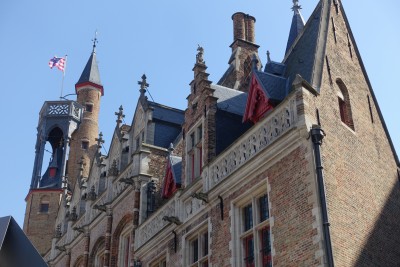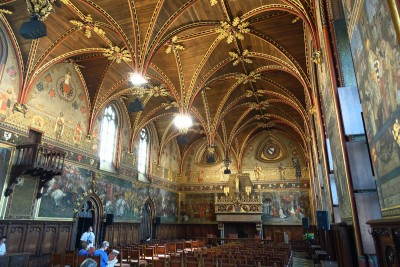Touristy and Enchanting Bruges
(vero;2023-Oct-15)
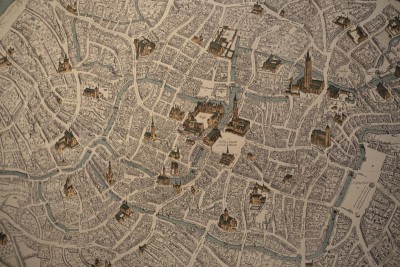
It is difficult not to love Bruges with its well preserved medieval architecture, the cobbled streets, the market squares, its soaring towers and the canals crisscrossing the city. Everything is picture-book perfect. So what's not to like? The crowds maybe: we were there in September with a splendid weather and the place was full to the brim with tourists, although it was not so bad as feared: huge groups are marched through the centre in the steps of their flag carrying guides but they keep to a well-defined area including the Market square, the Burg square, the Dijver and the area surrounding the Church of Our Lady.
The centre definitely left us with a sour taste with its crowded streets lined with chocolate and souvenir shops, ice-cream and waffle sellers: we had the feeling to be in an open-air museum more than anything else. But step a few hundred metres away in any direction and the town is suddenly quiet and you have the streets to yourselves while most of the tourists are all stuck in canal boats to see the city from the water (or queuing for them). We visited many museums and were really surprised by the few visitors we met while exploring them. They don't seem to be on the programme of the tour groups which is a very good thing indeed, many come to the city as a day-trip which means they simply don't have the time.
Somebody in the tourism office told us that Bruges has not recovered its pre-pandemic level of visitors yet: the Asian tourists are still missing, although they have observed an increase in francophone visitors and as for us, we had the feeling that half of Spain was there. We couldn't help but ask some locals about life in Bruges city centre: they told us that it was actually very pleasant and quiet as long as you avoid the touristy bit. And as we were wondering about the lack of shops for daily needs like small supermarkets, bakeries and butchers, they reassured us: there are some, you just have to know where they are…
Practicalities
We were based on the coast in the sea-side resort of Blankenberge and visited Bruges for two days; it was an easy drive and a quick access to the centre. We parked for free at the Park and Ride on Bevrijdingslaan in walking distance (20 minutes) of the centre.
The entry fees for museums and some monuments are quite high and we recommend buying either the Musea Brugge City Card for 33€ valid for 72 hours (3 consecutive days) if you plan to visit more than one or two of them or even best if you plan to visit more than one city in Belgium, the Belgian Museum Pass for 59€ valid for one year (not including all museums though, so make sure that the ones you want to see are included, search this page by city). Prices were valid at our time of visit in September 2023, both cards can be purchased online or at a participating museum. Don't forget to check the opening times before setting off: many museums are closed on Mondays (but not all).
Do not forget to check our photo gallery dedicated to Bruges to discover views of the city and have a peek inside some of our preferred museums. We have prepared a short description of the best to whet your appetite below:
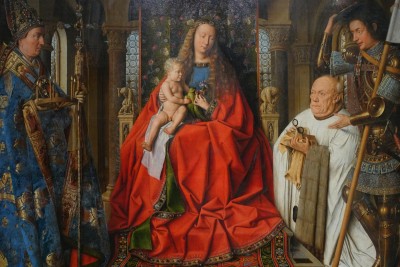
Groninge Museum: this museum should be on your list if you like medieval paintings and the so-called Flemish Primitives. You will find works by Van Eyck, Bruegel, Jan Provoost and Jheronimus Bosch just to name a few.
The rooms are not overloaded, the displays well arranged. We recommend. Don't forget to check our photo gallery dedicated to this museum.
Gruuthuse Huis: this museum is located in the former palatial mansion of Louis de Gruuthuse (ca.1427-1492), a Flemish courtier, lover of books, soldier and nobleman who was awarded the title of Earl of Winchester by King Edward IV of England in 1472, and was Stadtholder of Holland and Zeeland from 1462 to 1477.
You will get to see the interior of the house of a rich family as it would have been in the late Middle Ages as well as a comprehensive collection of tapestries, stained-glass windows, wooden sculptures, historic lace and manuscripts, each object bearing witness to the wealth and history of Bruges. One highlight is the late 15th century oratory connecting the palace and the Onze-Lieve-Vrouwekerk (Church of our Lady) and providing a view of the inside of the church from the mansion. We were pleasantly surprised by our visit which was much better than we had expected after reading our guidebook.
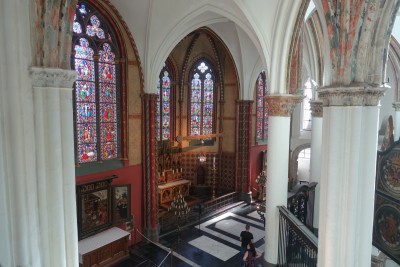
Onze-Lieve-Vrouwekerk (Church of our Lady): the church is open to everybody but one has to buy a ticket for the museum to see its treasures, among others the famous marble statue "Madonna and Child" by Michelangelo, a triptych of the Adoration of the Shepherds by Pieter Pourbus as well as the mausoleums of Charles the Bold (1433-1477) and his daughter Mary of Burgundy (1457-1482, she died young at the age of 25 after falling from a horse during a hunt).
Stadhuis and Brugse Vrije: the Stadhuis (City Hall), flanking one side of the Burg square is an arresting sight with its carved facade and Gothic extravaganza. It is well worth visiting the museum inside to see the Gothic Hall on the first floor, a grand ceremonial hall adorned with murals depicting key events of the city's history. There is also a room with a very worthwhile presentation explaining the development of the city over the centuries, how it had to re-invent itself constantly in order to retain its crucial and vital access to the North Sea (often impaired by a shifting coastline and the silting of its canals). The entry ticket gives also access to the Brugse Vrije, once the seat of the "Liberty of Bruges", an administrative body which ruled Bruges and its region from 1121 to 1794. The Vrije houses now the city archives and the only room open to the public is a renaissance assembly room adorned with copies of famous paintings and portraits as well as an impressive chimney featuring the Emperor Charles V.
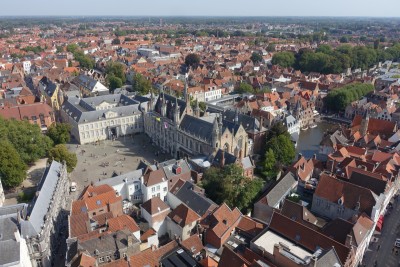
Belfort: you can't miss the belfry as it towers 83m high above the Market Square and can be seen from all over the city. We recommend climbing to the top for a bird-eye view of the city and its surroundings, plus the "chance" to hear the city carillon from near! The climb is steep and the only staircase quite narrow which means that the number of visitors is limited: this is one of the attractions where advance booking is a MUST (although there were slots available as we were there, you can book at a vending machine in the covered passage leading to the inner yard of the belfry).
Want to read more? Go back to Introduction or go on to Friendly and Engaging Ghent or go up to Blog
$updated from: Blog.htxt Mon 04 Mar 2024 16:04:48 trvl2 (By Vero and Thomas Lauer)$




